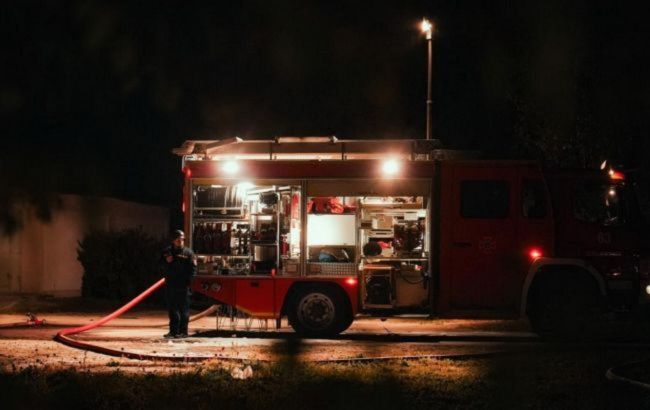Blackout at Chornobyl plant, Slavutych left without power, and Chernihiv on rolling outages - Russian strike aftermath
 Photo: A rescuer at the scene in Slavutych (t.me/dsns_telegram)
Photo: A rescuer at the scene in Slavutych (t.me/dsns_telegram)
On the evening of October 1, Russian forces struck Ukraine’s energy infrastructure. As a result, the city of Slavutych was left without a centralized power supply, the Chornobyl Nuclear Power Plant experienced a several-hour blackout, and Chernihiv and the surrounding region switched to scheduled outages.
RBC-Ukraine has compiled everything currently known about the aftermath.
Key questions:
-
Russian forces struck a power substation in Slavutych.
-
The attack caused a blackout at the Chornobyl Nuclear Power Plant and power disruptions across the Chernihiv region.
-
Slavutych remains without electricity; "Points of Invincibility" have been deployed.
-
The outage at Chornobyl lasted for over three hours, but there is no radiation threat.
-
Chernihiv and the region have switched to rolling outage schedules.
Target in Slavutych
During another drone attack on northern Ukraine, a strike hit an electrical substation in the city of Slavutych, Kyiv region.
Around 4 PM Kyiv time, the city lost power and water supply. Firefighters were immediately dispatched to the impact site. Mayor Yuriy Fomichov stated that the water supply would be gradually restored according to schedule and that "Points of Invincibility" were being established for residents.
He also published footage showing thick black smoke rising from the area near the substation.
Russian forces carried out a targeted strike on the evening of October 1, damaging a power substation in Slavutych and leaving the city without electricity and water. The Chornobyl Nuclear Power Plant was left without power for several hours, while Chernihiv and parts of the region switched to rolling outage schedules.
President Volodymyr Zelenskyy said the strike was deliberate, involving more than 20 drones, reportedly Shahed-type UAVs.
"Some of the drones were intercepted, but the attack was coordinated in waves to make the site’s defense more difficult," Zelenskyy noted.
Situation in Slavutych
Kyiv regional administration head Mykola Kalashnyk arrived at the scene, reporting that as of 10:30 PM Kyiv time, Slavutych remained without centralized power supply, with work underway to connect backup sources. Critical facilities were already operating on generators, the water supply had been restored, and the local hospital continued to function with alternative power.
Five supermarkets are operating around the clock as "Points of Invincibility," where residents can charge their phones and receive basic assistance. In addition, ten fully equipped shelters with heat, light, water, and tea have been deployed, with another ten emergency tents from the State Emergency Service (SES) expected to open by morning, all equipped with Starlink for stable internet access.
"Everyone can find help there and feel that we are together in this difficult situation," Kalashnyk said.
Telecom operators Kyivstar, Vodafone, and Lifecell have sent crews to the city. Thanks to generators at key network points, mobile service remains stable.
Chornobyl blackout and radiation safety
Around 8:45 PM Kyiv time, it was reported that the Chornobyl Nuclear Power Plant had gone dark due to the strike on Slavutych’s substation. Power fluctuations cut off electricity to the New Safe Confinement, the massive structure isolating the destroyed fourth reactor and preventing radioactive leaks.
President Zelenskyy later confirmed that the blackout lasted over three hours. He reminded that 80% of all spent nuclear fuel from the plant’s operation, over 3,250 tons, is stored at the site.
"The Russians could not have been unaware that hitting targets in Slavutych would cause such consequences for Chornobyl," he said, urging a strong international response.
By 11 PM Kyiv time, Energy Minister Svitlana Hrynchuk confirmed that all affected Chornobyl facilities had been reconnected to the grid. Radiation levels remained within control limits, posing no threat to the population.
Situation in Chernihiv and rolling outages
The strike also caused power outages in Chernihiv and several districts of the region. Within hours, the regional energy operator Chernihivoblenergo reported a critical situation in the power system.
Due to the massive attack, a systemic failure left more than 300,000 consumers without electricity. As generating capacity was insufficient, scheduled rolling outages were introduced from 8 PM across four rotation groups, three hours with power followed by six hours without.
Residents were urged to save electricity. The schedules will remain in effect until the situation stabilizes.
Chernihiv city’s water utility resumed partial operation using autonomous sources, maintaining sufficient pressure. Hospitals are powered by generators, schools have switched to remote learning until the end of the week, and kindergartens will remain closed on October 2.
Public transport continues operating as usual, while street lighting and traffic lights in areas without backup power are switched off. The local police have moved to enhanced patrol mode, and "Points of Invincibility" are being set up across the city.
In the wider region, Governor Vyacheslav Chaus said hospitals, utilities, and social facilities are transitioning to generators. Police have increased patrols in blackout areas, mobile operators are working under emergency protocols, and water delivery is being arranged for districts lacking alternative power for pumping stations.
Sources: the Ministry of Energy, Facebook of Slavutych Mayor Yuriy Fomichov, Telegram updates by Mykola Kalashnyk (Kyiv Regional Administration), Vyacheslav Chaus (Chernihiv Regional Administration), and Chernihiv city military administration head Dmytro Bryzhynskyi, as well as statements from President Volodymyr Zelenskyy.

